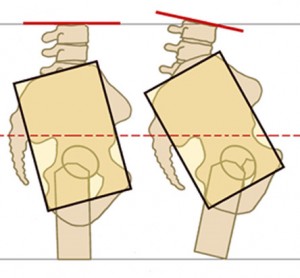Successful upright posture is dependent on the proper placement of the pelvis.
If your pelvis is situated correctly the arms, legs, and trunk can be well aligned.
The problem is that I think most people tuck their pelvis under which makes walking, standing, and sitting well very difficult.
A large part of my work is convincing people that they tuck their pelvis habitually.
Most people think they don’t, or if they do, it is because they think they should. I am here to proclaim otherwise. We must stop tucking our pelvises.
There are three simple ways to know if your pelvis is in the right position:
- Your butt (gluteus maximus) should be relaxed when standing or walking on a level surface.
- Your butt should have a home of its own, not hang down on the hamstrings at the back of the thigh.
- A kegel, or pelvic lift, should travel energetically up the spine with no interference from the pubic bone or sacrum.
Figure out how to get your pelvis into this position and you have gone a long way towards alleviating pain and possible injury.
A number of muscles will need to change in length and tone to accommodate this new skeletal alignment, but that is just part of the process.
But when it comes to the tailbone, feel free to tuck.
The key to tucking the tailbone is that it is the only thing moving when you tuck it.
The tailbone, or coccyx, is the very base of the spine.
It is made up of three to five bones that fuse soon after birth to form a solid vestigial tail.
A thick layer of muscles called the levator ani connects the tail bone to the pubic bone and the sit bones (ischial tuberosities).
These are the only muscles that should work to move the tailbone.
The tailbone articulates with the sacrum.
There is a moveable joint between the tailbone and the sacrum so if you tone or lift your pelvic floor you should feel the tailbone move, or tuck, towards the pubic bone.
The important part of that action is that the pelvis doesn’t move with the tail bone.
The pelvis stays in its neutral position and the tail moves forward lengthening the spine and creating the energetic convergence that is often referred to in yoga as mula bandha.
I spend my teaching hours staring at muscles, bones, and the wrinkles of clothing.
I hope to impart a need to develop a subtle ability to move gracefully from the core.
Exploring the alignment of the pelvis and its movement possibilities is a great way to begin to learn about the body.
Find your pelvis at neutral and then try to move your tail without moving any other bone.
The important thing we are trying to develop is the ability to move the pelvis and tailbone separately.
Not easy for everyone but well worth working on.
***

